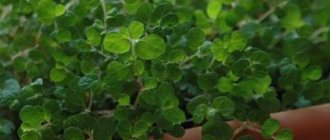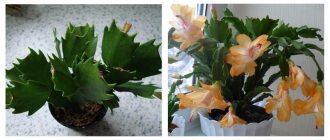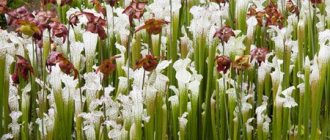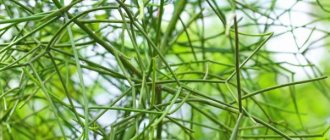Growing pachypodium from seeds
Despite the fact that the described plant is a succulent, it reproduces very poorly from apical cuttings.
If you want your pachypodium to appear before the “babies” form at the base, then for propagation at home, it is recommended to use the seed method.
Best time
The best period for growing plants from seeds is summer, since the air temperature will be at a fairly high level, which will contribute to better germination and normal development of seedlings.
Seed preparation
A feature of pachypodium seeds is the rapid loss of germination, therefore, in order to obtain successful results in growing the plant, it is necessary to use fresh seeds.
Before sowing, planting material must be soaked in warm water (up to +35 °C) and left for about three hours.
Sowing and caring for seedlings
To prepare suitable soil for sowing seeds, you need to use leaf humus - 1 part, charcoal - 1 part, turf soil - 0.5 parts, vermiculite - 1 part, sand - 4 parts, bone meal - 10 g.
Soil is poured into the selected container and watered. At the same time, one can observe the settling of the substrate and the leveling of its surface. Next, you need to spread out the seeds so that there is an interval of 3 cm between them and cover them with a five-centimeter layer of substrate.
The sprayer must be used to water the crops. Next, the container should be placed in a transparent plastic bag. To prevent condensation from forming, make a series of punctures in the bag using a large needle.
Seedlings should be watered regularly, without waiting for the substrate to dry out. Air humidity should be at 80%, and seedlings must be ventilated regularly, about 3 times a day.
When the first shoots appear, the package should be removed completely. The optimal temperature for keeping seedlings is considered to be +25 °C and above.
The rate of seed germination depends on the conditions of the crops and can range from 1 to 4 weeks. If the seeds do not germinate within 6 weeks, they are considered not viable.
After seed germination has occurred, air humidity should be reduced to 60%. Seedlings should be placed in direct sunlight before 11 a.m. and after 5 p.m. The rest of the time, crops need diffused sunlight.
Did you know? Pachypodium originated in Madagascar, from where it spread throughout the world, and the name “Madagascar palm” is associated with this fact.
Types of pachypodium domestica
In the natural environment, there are more than 20 species of Pachypodium. Some of them have taken root well at home.
Pachypodium lamerei / Pachypodium lamerei
A tree with an erect, thick stem strewn with large thorns. The lower part is thickened. Spiral-shaped thickenings run along the entire trunk. The top is decorated with a rosette of elongated lanceolate leaves attached to the base by long petioles. It blooms with large cream flowers with a soft pink tint. The throat of the flowers has a yellow tint.
Pachypodium geayi
A tree with a thorny thick trunk. The spines are gray with a black tip. Dark green leaves with a vertical brown-red stripe in the center are covered with delicate hair. The flowers are snow-white with a yellow spot in the center. The height of the tree is up to 0.5 m.
Pachypodium brevicaule
A spiny, succulent tuberous stem, the diameter of which reaches 0.6 m. When there are no leaves, it merges in shape and color with the stones surrounding it. It blooms with yellow small flowers of an elongated shape.
Pachypodium saundersii
The height of the spherical stem reaches a little more than a meter. The spines are few. The leaves are lanceolate, wide, and slightly pointed at the end. It blooms magnificently with white flowers with lilac stripes.
Pachypodium succulentum
The height of the tree is up to 0.5 m. The diameter of the thickened lower part reaches 0.15 m. It has numerous side shoots, their length reaches 0.9 m. The shoots are strewn with long spines and lanceolate pubescent leaves. It blooms in summer with pink flowers with a scarlet throat. The flowers look like bells.
A thorny tree with a silvery powerful stem stands firmly in a flowerpot. The graceful tuft at the top adds a playful touch to its look, and the bright flowers add charm. Pachypodium is an original plant that selflessly gives its owner joy and a sense of security.
Pachypodium - what kind of flower is this, what does a cactus look like
The pachypodium flower does bear some resemblance to a palm tree, thanks to its leaves located at the top of a thick trunk. However, these plants do not have any related connections. It belongs to the Kutrovaceae family, which means it is not a palm tree, but a Pachypodium cactus.
Pachypodium lamera
Brief description and characteristics
The difference between pachypodium and other succulents is its powerful, thick trunk. There are 3 groups of plants, depending on the type of trunks:
- Dwarf - the trunk is short and thick. The height of the trunk is most often equal to its width or even inferior to it, not exceeding 10 cm.
- Shrubs. Their trunk in nature reaches 4 m. The width is smaller and the shape is similar to a bottle.
- Cactus-like trees. Long, powerful plants, in nature can grow up to 8 m, at home, as a rule, they do not exceed 1.5 m. The shape of the trunk is similar to a cigar. Branching is possible.
Interesting! Pachypodium is translated from Greek as “thick leg.”
Pachypodium toxicity
The stem of Pachypodium is poisonous. It contains juice, which, when it comes into contact with the skin and mucous membranes, causes allergic reactions, redness and irritation of the skin.
In order to prevent this, immediately after accidental contact with plant sap, you need to thoroughly rinse the affected area with a stream of cold running water.
Important! If there is a plant in the house, it must be isolated from children and pets.
Conditions of detention
Despite the unpretentiousness of pachypodium varietal species, the plant is sensitive to external conditions. The tree grows slowly; if basic maintenance requirements are not met, it can go into hibernation and stop development. It is recommended to provide high-quality lighting, moderate humidity and choose the right place for growing.
Lighting
Pachypodium is a light-loving palm; with regular darkening, its decorative effect is reduced and growth slows down. The plant prefers continuous and diffused light; exposure to direct sunlight can lead to drying of the leaves and trunk. In summer it is possible to keep it on a glassed-in balcony or loggia, but it is advisable to bring the pot home at night. It is recommended to place the tree on the eastern or western windowsill of the apartment.
Temperature and humidity
The plant has pronounced periods of dormancy and vegetation. Active growth is observed from spring to early autumn, during which time it is recommended to maintain the temperature in the range of 18-28 oC. In winter, when the palm tree is dormant, the heat should be reduced to 14-17 oC.
Like other succulents, pachypodium can tolerate prolonged drought. The flower is unpretentious to indoor humidity and feels comfortable in an apartment at any time of the year. To maintain the health and elasticity of the leaves, it is enough to follow the watering regime.
Soil and pot
To grow pachypodium, you can use a ready-made store-bought mixture for cacti and succulents. The main requirements for the soil are high looseness and neutral acidity. You can prepare the substrate yourself by mixing garden soil, coarse sand and peat in equal proportions. Additionally, it is recommended to add pieces of brick chips and lumps of clay.
There are no specific requirements for capacity. Flower growers practice growing this crop in wide, low pots made of light ceramic - it helps maintain a stable soil temperature.
Pachypodium care reproduction description photo video watering lighting
Pachypodium is a succulent plant with a rather thick, fleshy stem and thin leaves at the top, forming a kind of tuft. It belongs to the Kutrov family and has about twenty species, the smallest of which fit in the palm of your hand, and the height of the larger ones exceeds the height of a three-story house. As a potted plant, all Pachypodium grow no more than seventy centimeters in height.
The natural habitat is Australia, Africa and areas of Madagascar with an arid climate, where these plants feel so good that they amaze the imagination with their size and bizarre shape. There are many wild species of pachypodium; only a few of them can be found in the apartments of amateurs.
Lighting. Pachypodium prefers bright direct sunlight, without shading, but can also grow in partial shade (in this case the plant stretches out and becomes less decorative).
Windows with southern, southwestern and southeastern exposure are well suited for growing plants. In summer, the pot with the plant can be exposed to fresh air, in a warm, brightly lit place by the sun, gradually accustoming it to the new lighting.
If there were few bright days in the autumn-winter period, then in the spring, with increasing illumination, it should be gradually accustomed to direct sunlight in order to avoid sunburn, and the same should be done with the purchased plant.
Temperature
An important condition for growing pachypodium is sufficient air and soil temperature and the absence of drafts. In summer the temperature can be even higher than 30°C, in winter – not lower than 16°C (for pachypodium Lamera not lower than 8°C)
Window sills above radiators are well suited for the plant.
In the autumn and winter months, the trunk of a number of plants may naturally become bare (leaf fall) and the tuft of leaves moves higher and higher along the trunk.
Watering. From March to October, plants are watered abundantly; the earthen ball should always be slightly moist
Water carefully - pachypodium does not like excessive waterlogging of the soil; if it is overwatered, the roots and part of the stem can rot. Always water with warm and well-settled water.
Watering in winter is reduced, especially for species that shed leaves; for others, the earthen clod is not allowed to completely dry out.
From October to March, watering for plants that shed leaves is very limited to avoid root death. When leaves fall, it is recommended to stop watering for several weeks and resume it only after new foliage appears.
Air humidity. Air humidity does not play a significant role. Pachypodiums normally tolerate dry air; it is not necessary to spray the plants (except to wash off dust from the leaves).
Fertilizer. Fertilizing in spring and summer once every two weeks with fertilizer for cacti. During the first month after transplantation, the plant is not fed. It must be remembered that in mineral fertilizers the level of nitrogen should be less than other elements, since excess nitrogen can cause root rot, normally you can adhere to the following ratio: nitrogen (N) - 9, phosphorus (P) - 18, potassium (K) - 24. It is better to refrain from using organic fertilizers.
It is advisable to add charcoal and brick chips to all substrates.
Good drainage is necessary (at least a third of the height of the pot).
The plant is suitable for hydroponic culture.
Reproduction. Pachypodium is propagated by seeds at temperatures above 20°C. Unlike many succulents, pachypodium stem pieces have difficulty rooting. However, you can try to root the upper part of the plant if the lower part is irreversibly rotten, after drying it and sprinkling it with charcoal.
Propagation by cuttings
The scheme is as follows: cut the cutting growing at the very top, sprinkle the cut area with charcoal and immediately transplant the flower into a new container.
In order for the sprout to take root, we plant it in the same soil where the adult plant was located.
The most viable sprouts are fifteen centimeters long.
The cutting requires the same care as an adult “palm tree”.
Sprouts are traditionally planted in the first spring months.
Propagation by seeds
You can hear from experienced gardeners that cuttings do not always take root, even if the care was correct. Therefore, many are inclined to propagate with seeds, which can be bought at any highly specialized store. Each seed is planted half a centimeter into the soil and cared for like an adult plant.
If gardening chores do not bring you much joy, you should think about purchasing a “ready-made” pachypodium in a pot. Its price will depend on the variety and height of the plant.
Description of the plant
This flower belongs to the Apocynaceae family. Its appearance depends on the external factors of the area in which it grows. In nature, there are about twenty-five species of Pachypodium, the sizes of which start from a few cm in height (much larger in width) and end with cactus-like trees up to eight meters in height and one and a half meters in diameter. Shrub species of Pachypodium with bottle-shaped trunks grow up to 4 m in height. In indoor conditions, the flower grows slowly and stretches to a maximum of one meter.
Instances of the plant are found in crevices and cracks in dry hilly areas in the mountains of Australia, Madagascar, as well as in some countries of continental Africa with the driest climate: Angola, Mozambique, Zimbabwe, South Africa and other countries. Some types of Pachypodium prefer a certain type of soil, while others tolerate different types of soil.
The trunks of Pachypodiums usually have long, thickened spines. In some species they cover the entire surface of the trunk, while in others they cover only near the leaves. Supplies of moisture and nutrients are replenished by the plant and accumulated in the trunk at any opportunity (for example, during the rainy season) and are used during long periods of drought. In addition, some types of Pachypodium have thickened underground trunks (caudexes) that serve the same purpose. During drought, the plant's thorns are capable of extracting moisture from fog and dew.
At the top of the trunk there are thin narrow leaves that grow in a spiral pattern. As the plant grows, the lower leaves die off, the trunk becomes bare, and the crown of leaves rises closer to the top. The leaves are located on short petioles and have different shapes: obovate or linearly rounded. Their surface is painted dark green with a pronounced gloss. The midrib is lighter and clearly visible. The back side of the leaf is velvety to the touch and slightly lighter than the front.
Wild species of Pachypodium bloom with very beautiful large flowers. Their shape is regular, with five petals overlapping each other. The color is white, pink or yellow, there are variations. The flowers emit a strong aroma. At home, unfortunately, it is very difficult to achieve flowering, but it is possible. Most often, the flower is purchased exclusively as a decorative foliage exotic with a non-standard, original appearance and unassuming character.
Reproduction of pachypodium at home
The photo shows pachypodium seeds
In the wild, pachopodium trees and bushes reproduce by seeds; at home, you can also try to grow a plant from seeds, but a novice gardener may encounter an unexpected difficulty: they germinate very slowly and are difficult to purchase. Guaranteed good seeds can be bought either in large specialized seed stores or sent by mail, but in this case there is no guarantee that they will sprout, since there is no guarantee that it will be pachypodium.
In order to grow a tree from a seed, albeit a small one, you will need patience. The seeds are planted in a small pot; you can take soil intended for cacti. Plant, water and cover the top with glass or film, place in a sunny place. The sprout will appear quickly, in about a week, after which the film is removed, and the small pachypodium is grown in a sunny place, watered regularly. Interestingly, even a five-centimeter baby already has sharp spines on its stem.
Lameri can be propagated by lateral shoots; before planting, they are separated and dried for two or three days. After this, they are planted in the soil, but very often the shoots simply live on it for a month or two, without giving roots, then, when the food supply runs out, they die.
Folk signs and superstitions
The following signs and folk beliefs are associated with the Madagascar palm tree:
- palm trees accepted as a gift will bring grief to the family; to avoid misfortune in the house, you need to buy the flower with a coin;
- the Madagascar palm tree transforms negative energy into positive;
- when the pachypodium begins to bloom, the house is filled with love and goodness;
- the flower will protect its owners from unfriendly guests, they will feel tired;
- in the house in which this flower is located, fidelity will remain, all family members will become closer;
- since pachypodium belongs to the cactus family, it cannot be kept in the bedroom, because the flower can adversely affect human health;
- cacti and flowers of the cactus family contribute to the emergence of alcoholism in the family, and unmarried girls are condemned to the crown of celibacy;
- single women who collect different types of succulents can find a man and get married successfully.
Whether to believe these signs and superstitions is a personal matter for everyone. But despite this, there are many couples who live happily growing pachypodium
Pachypodium is a fairly popular, although unsafe flower in everyday life, which requires sufficient care and precautions. Knowing signs and superstitions and believing in them, you can prevent problems in the family
Was this article helpful?
Thank you for your opinion!
You can recommend this article to your friends!
You can recommend this article to your friends!
Yes
No
Methods of propagation of the Madagascar palm
It is not difficult to grow your own exotic tree practically from scratch; for this you can use seed material or resort to the cutting method. Each method is effective, the main thing is to follow the basic rules:
Sowing seeds and caring for seedlings
In its natural environment, pachypodium reproduces exclusively by seeds. To collect material from a houseplant, secure the ripening, light brown pods with ribbon or a string of yarn. This will prevent the fruit from splitting when it comes time to release its contents.
Before planting, you should prepare a special soil substrate: for 4 parts of coarse washed sand, take 1 part of well-rotten organic matter - compost, the same amount of perlite and vermiculite. The mixture should be sterilized before use.
Seeds are sown in the summer, deepened by 5–6 mm, the depth should not exceed 10 mm. The distance between the seeds is 3–4 cm.
The container with the planting is placed in a warm, dry place. The optimal air temperature is considered to be between 27 and 35 degrees. Seeds that have not hatched after 1.5 months are not viable.
Sprouts with 3–4 leaves are ready to be transplanted into separate pots; drainage is required.
Rooting stems and cuttings
To propagate pachypodium using similar methods, you can use parts of the stem and root cuttings:
10–12 cm sections of young, healthy branches are cut off; It is better to do this in the spring, in May. The cut areas are washed under running water to remove the released milky juice. Then the sections should be dried in the open air until a crust forms at the cut site. You can treat the ends of the cuttings with a preparation that stimulates root formation. For rooting, use a substrate with a light, air- and waterproof consistency; sand is also suitable for these purposes. It is recommended to moisten the soil occasionally; you can irrigate it with a spray bottle.
It is important to avoid excess moisture and stagnation.
Cuttings do not immediately produce roots, so the grower needs to be patient. It is possible to grow a new plant from part of the root, but this method is used very rarely.
Most often, pachypodiums are grown from seeds, but vegetation methods are often the only way to save a sick, rotten flower.
Varieties of succulent
To date, 23 species of Pachypodium have been recorded and studied. But only some of them are suitable for indoor use:
- Pachypodium Lamerei Drake
It was thanks to him that these plants were nicknamed Madagascar palms. The succulent comes from Madakascar, where it has taken a fancy to the limestone rocks. Pachypodium lamera is a tall tree; in nature its height can reach 6–8 meters.
The straight stem of the succulent becomes woody and, in rare cases, branches. At the bottom it is slightly thickened, covered with small convexities arranged in a spiral. Each tubercle has three well-developed spines.
The upper part of the stem is decorated with a dense rosette formed from dark green foliage. The leaf blades are elongated, lanceolate in shape, their length varies from 13 to 30 cm with a width of 4–9 cm. In cultivated specimens, their sizes are much more compact. The rounded tops of the leaves have a small point. There is no edge. There are 3 bare spines above each leaf.
The flowers of Pachypodium lamera are white-cream, with a delicate pinkish tint and a yellow throat.
In nature, the height of this tree can reach 8 meters, although 3–6 meter specimens are most often found. A succulent of this species resembles the previous representative in appearance, this is especially noticeable in young plants. Only its leaves are already covered with edges, young spines are light gray, black at the tips. The inflorescences are snow-white, with a yellow center. When grown indoors, the plants grow into 50–60 cm trees.
Another representative of the genus comes from Central Madagascar, which amazes with its ability to mimic. Shedding its leaves, the succulent becomes like gray stones due to the succulent, flat, tuberous, spiny stem that blends into its surroundings. The flowers of the short-stemmed pachympodium are yellow and elongated.
The Madagascar guest with a strong, fleshy gray-green trunk grows to almost a meter in height at home. Like other pachypodiums, its foliage crowns the top of the trunk. It is characterized by very slow growth and begins to bloom only when its diameter reaches 30 cm. In winter, due to a lack of natural light, it often sheds its leaves.
It is called Saunders' Pachypodium or Lundy's Star. The succulent has an almost spherical stem, greenish-gray in color, with rare spines no more than 25 mm long. Leaf blades are in the form of wide lancets, with slightly pointed tips. Pachypodium Sanders blooms profusely with white flowers with pink stripes.
This exotic inhabitant came to us from the Cape Province of South Africa. It has a strongly pronounced trunk with significant thickening at the base. In the natural environment, the trunk is more or less submerged in the soil.
The branches are strong, equipped with 1–2 cm paired spines. Leaf blades are lanceolate with a small edge. In the summer, adult plants produce bell-shaped flowers, 3–4 cm in size, pink in color, with a deep red throat.
This small compact succulent with a thickened trunk at the base is also native to Madagascar. It has grayish-green lanceolate foliage that forms rosettes at the tops of branches. The surface of the trunk is smooth, green with a silvery tint.
While still a young plant, Pachypodium horombenze intensively branches, and its branches often grow from the lower thickening of the trunk. It blooms very spectacularly; it has large yellow flowers that form racemose inflorescences. When planting pachypodium seeds of this variety, the flowering period can be expected in 24–48 months.
In nature it is a 2–3 m tree, in apartment conditions it is a 1–1.2 m plant. The foliage is green, lanceolate, elongated. The trunk has a smooth, brownish-silver surface. The flowers are large, have a pronounced pleasant aroma, they have pink petals and red corollas. Southern pachypodium grows faster than most other representatives of the species.
Looking at the pachypodium, it immediately becomes clear that this is not a local, but an exotic representative of the flora and it may seem that at home it needs very complex care. But this opinion is fundamentally wrong; even a novice gardener can grow such an impressive and unusual plant, since the succulent is relatively unpretentious and picky.
Reproduction of pachypodium
Pachypodium propagation is carried out using seeds or cuttings.
Propagation of pachypodium by cuttings
If the cactus trunk begins to rot, the pachypodium is propagated by cuttings. The method makes it possible to save the pachypodium. Use a sharp knife to cut off a healthy fragment. The cut area is blotted with a napkin and sprinkled with charcoal powder. Dry for some time until a protective film appears. Then planted in substrate or sand. Keep at + 26°C, sometimes watered.
Growing pachypodium from seeds
The main option for obtaining a new cactus. Before planting, seeds are soaked in a warm solution of potassium permanganate. After 2 hours, they are sown in the soil at a distance of 40 mm from each other, deepened by 10 mm. Cover with film. The seedlings are ventilated daily and watered rarely - when the substrate dries out. When shoots appear, the film is removed. When the first 2 leaves appear, the seedlings are planted in separate containers.
Getting a new pachypodium is a long process. It takes a lot of time to root cuttings
It is important to maintain moderation in watering so that the base of the trunk does not rot.
Diseases and pests
Most of the problems Pachypodium (Madagascar palm) experiences are due to poor quality care:
- 1If watering is improper, a sharp drop in temperature, or a change of “place of residence,” the plant sheds its leaves.
- 2If there is an excess of moisture in the soil and air, various types of rot can develop (on the root system, trunk, foliage).
- 3 In a draft, the foliage turns black, withers and falls off.
The palm tree is susceptible to attack by spider mites, thrips and scale insects. Due to the high thorniness of the trunk, it is quite difficult to cope with insects with your own hands, so it is better to spray Pachypodium with special means, for example Actellik or Fitoverm.
Flowers affected by mites are distinguished by pale and yellow foliage. White spots can be seen on the top of the leaf. The foliage flies off ahead of time. You can see rusty spots between the thorns on the trunk.
Dry air in the room contributes to the appearance of red mites. Pest control measures are simple. Spraying should be carried out using the following means:
- 1Derris.
- 2Fitoverm.
- 3Fufan.
- 4Actellik.
In addition to mites, thrips can infect the flower. It is provoked by incorrect temperature conditions and low moisture levels. A sign of thrips is the appearance of many colonies on the bottom of the leaf and white dots on top. As a result, the top of the leaf changes color to gray-brownish with a silvery sheen. Thrips can be destroyed. The Madagascar palm tree must be sprayed with insecticides:
- 2Fitoverm.
- 2Decis.
- 4Actellik.
- 4Inta-vir.
The fact that the plant is sick is most often indicated by black, slightly stained foliage. The reason for this is usually excessively low temperatures in winter and too frequent watering. If the plant is moved to a dry and warm place, it will recover without unnecessary help from the grower.
Pachypodium is very susceptible to rotting, so you need to monitor the watering regime; it should not be over-watered or over-dried. It is necessary to ensure that the soil is moist. With proper care, the stem will have a beautiful shape, it will not become crooked and thin.
Planting and caring for pachypodium
- Flowering: in spring, first time - in the sixth or seventh year of life.
- Lighting: bright diffused light.
- Temperature: in summer – from 20 to 30 ºC, in winter – 16-18 ºC. Protect the plant from drafts!
- Watering: in spring and summer - moderate, when the substrate dries to a depth of 1 cm, in winter - rare and meager. After dropping the leaves, stop watering. The short-stemmed species requires scanty watering throughout the year.
- Humidity: normal.
- Feeding: from early spring to mid-autumn once a month with fertilizers for cacti.
- Dormant period: approximately November to March.
- Transplantation: young plants - every spring, adults - once every 3-4 years.
- Reproduction: by seeds, less often by cuttings.
- Diseases: fungal rot.
- Pests: spider mites, thrips.
- Properties: the plant has poisonous juice!
Read more about growing pachypodium below.
Care
Lighting. Pachypodium prefers bright direct sunlight, without shading, but can also grow in partial shade (in this case the plant stretches out and becomes less decorative).
Windows with southern, southwestern and southeastern exposure are well suited for growing plants. In summer, the pot with the plant can be exposed to fresh air, in a warm, brightly lit place by the sun, gradually accustoming it to the new lighting.
If there were few bright days in the autumn-winter period, then in the spring, with increasing illumination, it should be gradually accustomed to direct sunlight in order to avoid sunburn, and the same should be done with the purchased plant.
Temperature
An important condition for growing pachypodium is sufficient air and soil temperature and the absence of drafts. In summer the temperature can be even higher than 30°C, in winter – not lower than 16°C (for pachypodium Lamera not lower than 8°C)
Window sills above radiators are well suited for the plant.
In the autumn and winter months, the trunk of a number of plants may naturally become bare (leaf fall) and the tuft of leaves moves higher and higher along the trunk.
Watering. From March to October, plants are watered abundantly; the earthen ball should always be slightly moist
Water carefully - pachypodium does not like excessive waterlogging of the soil; if it is overwatered, the roots and part of the stem can rot. Always water with warm and well-settled water.
Watering in winter is reduced, especially for species that shed leaves; for others, the earthen clod is not allowed to completely dry out.
From October to March, watering for plants that shed leaves is very limited to avoid root death. When leaves fall, it is recommended to stop watering for several weeks and resume it only after new foliage appears.
Air humidity. Air humidity does not play a significant role. Pachypodiums normally tolerate dry air; it is not necessary to spray the plants (except to wash off dust from the leaves).
Fertilizer. Fertilizing in spring and summer once every two weeks with fertilizer for cacti. During the first month after transplantation, the plant is not fed. It must be remembered that in mineral fertilizers the level of nitrogen should be less than other elements, since excess nitrogen can cause root rot, normally you can adhere to the following ratio: nitrogen (N) - 9, phosphorus (P) - 18, potassium (K) - 24. It is better to refrain from using organic fertilizers.
Transfer. Overgrown plants are replanted no more than once every two to three years, young ones annually. When replanting, you need to handle the roots carefully - Pachypodium's roots are very delicate. A permeable and nutritious substrate of peat with sand and a small amount of turf soil (pH 5-7) is suitable for replanting. Although in their homeland pachypodiums often grow on limestone, they can be cultivated in moderately acidic substrates, which can be composed of equal parts of turf and leaf soil with the addition of coarse sand. You can use a ready-made substrate for cacti.
It is advisable to add charcoal and brick chips to all substrates.
Good drainage is necessary (at least a third of the height of the pot).
The plant is suitable for hydroponic culture.
Reproduction. Pachypodium is propagated by seeds at temperatures above 20°C. Unlike many succulents, pachypodium stem pieces have difficulty rooting. However, you can try to root the upper part of the plant if the lower part is irreversibly rotten, after drying it and sprinkling it with charcoal.
Propagation by cuttings
The scheme is as follows: cut the cutting growing at the very top, sprinkle the cut area with charcoal and immediately transplant the flower into a new container.
In order for the sprout to take root, we plant it in the same soil where the adult plant was located.
The most viable sprouts are fifteen centimeters long.
The cutting requires the same care as an adult “palm tree”.
Sprouts are traditionally planted in the first spring months.
Propagation by seeds
You can hear from experienced gardeners that cuttings do not always take root, even if the care was correct. Therefore, many are inclined to propagate with seeds, which can be bought at any highly specialized store. Each seed is planted half a centimeter into the soil and cared for like an adult plant.
If gardening chores do not bring you much joy, you should think about purchasing a “ready-made” pachypodium in a pot. Its price will depend on the variety and height of the plant.
Transfer
Pachypodiums usually grow very slowly, growth is about 5 cm per year. Therefore, they do not need frequent transplants. A young bush can be transplanted a year after planting into a slightly larger pot, and after that two or three years will pass when it may need the next transplant. It is performed before the onset of cold weather or in early spring.
This may be interesting: Prickly pear - growing at home
It is better to purchase soil for a flower in a special store, suitable for cacti and succulents. If you decide to prepare the soil yourself, then you will need humus, sand, leaf and turf soil. It is advisable to add pieces of charcoal and brick chips to all substrates. All components must be disinfected (spilled with boiling water or manganese). At the bottom of the pot, a third of its height, place a layer of clean expanded clay or other drainage material (small pebbles, aquarium soil, pebbles).
What to do with thorns?
Replanting Pachypodium is not so easy, because its stem is sometimes completely strewn with sharp thorns. Thick gloves won't help here either. In nature, succulents need spines both as protection from insects and herbivores, and as water collectors. Any atmospheric moisture, be it fog or fallen dew, is absorbed by the thorns, replenishing moisture reserves in the fleshy stems of the plant. In indoor conditions this is not so important. If you want to protect yourself from injury when caring for a thorny flower, trim the sharp thorns with clean scissors, making them blunter and safer.
After this, putting on thick gloves on your hands, you can remove the flower from the old pot and, together with a lump of earth, carefully move it into a new pot prepared for replanting. Please note that Pachypodium roots are very delicate and can easily break. Therefore, try to handle them carefully during transplantation. Sometimes the soil surface is covered with gravel or decorative stones.











